- Analysis
- Sport
- FIFA World Cup
This was published 2 years ago
At up to $2000 a season, will the cost of kids’ soccer keep a cap on the boom?
By Andrew Wu and Cara Waters
Australian sport has had plenty of “where were you moments”: the semi-final tie at the 1999 cricket World Cup, Cathy Freeman’s gold in Sydney and John Aloisi’s penalty kick in 2005 to name a few. On Thursday morning Mathew Leckie added his name to the list.
And you can be sure in the years to come when fans reminisce about that moment, there will be more than 8000 who will say they were part of the raucous yet joyful scenes at Melbourne’s Federation Square in the early hours of a cool Thursday summer morning celebrating a landmark moment for Australian soccer.
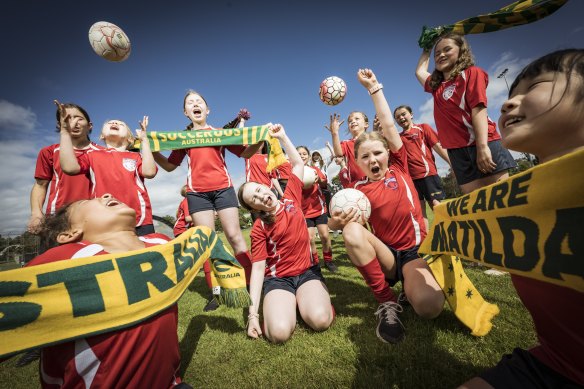
Members of the Darebin Falcons football club are getting ready to cheer the Socceroos on in the World Cup. Credit: Chris Hopkins
With the Socceroos’ success at this year’s World Cup, and Australia co-hosting the Women’s World Cup with New Zealand next year, there has been a boost in interest in the sport.
However, soccer club officials warn the high costs of playing the game – up to $2000 at some junior clubs - means some kids who want to may be denied the chance.
Football Australia chief James Johnson has conceded costs associated with elite junior pathway system are too high.
Socceroos coach Graham Arnold called for an in-depth review of Australia’s soccer pathways this week and said he fears for the future if Australia’s young soccer talent aren’t given greater opportunities and junior teams continue to struggle with limited resources.
The mayhem at Federation Square was replicated in pubs around the country, caught on cameras and posted to social media for perpetuity, while an average audience of 618,000 tuned in at 2am on SBS’ various platforms to see the Socceroos advance to the round of 16 of the World Cup for the first time in 16 years.
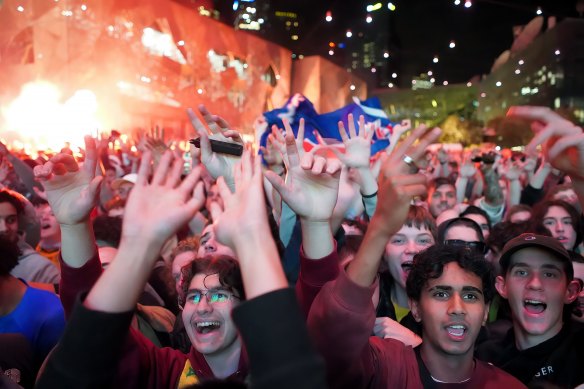
Australian fans celebrate during the Socceroos’ win over Denmark.Credit: Luis Enrique Ascui
“I truly believe that the Socceroos are the team that unites the nation,” Arnold said.
“You don’t see when the cricket World Cup’s on, Federation Square like it is, pubs like they are. Rugby union, rugby league, anything: the World Cup of football unites the nation.”
It’s a claim few would contest, but also raises the question as to why soccer remains well behind Australian rules football and rugby league in terms of popularity and media coverage despite its ability to create such dizzying highs.
Soccer administrators are accustomed to the spikes that come every four years with the World Cup, but you do not need to be a dietician to know about the side effects of a sugar hit.
These should be heady times for the game in this country. After Aloisi’s fabled kick from the spot ended a 32-year drought, the men have qualified for the past five World Cups, reaching the second round twice. The Matildas have not missed a World Cup since 1995, reaching the round of 16 or quarter-finals in the past four tournaments. In Sam Kerr, the country has one of the most recognised female players in the world. And there is about to be the women’s World Cup on these shores.
But domestically, the sport is battling. There was upheaval during the pandemic when the game lost a string of major sponsors, including A-League naming rights-holder Hyundai and TV partner Fox Sports. The national league is not dragging people through the turnstiles or attracting eyeballs at home.
In 2020, the then Football Federation Australia unveiled XI Principles, a discussion paper to underpin the future development and growth of the game. The governing body’s rebranding as Football Australia was part of this change.
Johnson said the code needed to play to its strengths. It had a more multicultural and diverse following than any other sport in this country, he said, and was a truly global game.
“So I think what we’ve got to do is move away of trying to replicate what the NRL and AFL are because that’s not who we are,” Johnson told The Age and the Herald from Doha. “We have our own identity, and we’ve got to play to it.”
The widespread popularity of the national teams has not transferred to the A-League Men. Average crowds for the league have returned to pre-COVID levels of about 9000 but are well down on the 14,610 in 2007-08 when the fledgling competition was riding the highs generated by the so-called golden generation of Socceroos. TV numbers are also low. Network Ten, in the second year of a $200 million contract, moved games to its secondary channel 10 Bold after poor numbers last season.
Johnson is optimistic the A-League Men, now run by Australian Professional Leagues and not FA as part of a change to the governance structure, can seize the momentum from the World Cup and convert the crowds at Federation Square watching the Socceroos into bums on seats at local games.
Johnson said average crowd sizes of 15,000 are “certainly achievable”, a sentiment shared by A-Leagues chief Danny Townsend.
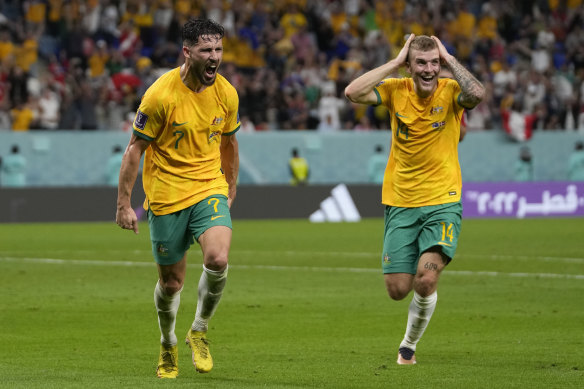
Mathew Leckie celebrates his match-winning goal against Denmark.Credit: AP
Townsend disagrees with criticism of the quality of the A-League Men. He and Melbourne City captain Scott Jamieson, who plays alongside Leckie at club level, both say soccer unfairly suffered from comparisons to top-level leagues in Europe.
The Socceroos’ effort in Qatar is a strong counterpoint to those who turn up their noses at the local game. Twenty of Arnold’s 26-man squad were either developed in Australia’s domestic competition or are still playing in it.
“The AFL can’t talk about their quality because they’ve got nothing to compare themselves to,” Townsend said.
“Rugby league can’t say the same thing. We’re part of a global phenomenon and we’re playing our part. We’re really proud the number of players under 23 playing A-League minutes is greater than ever before, which shows we’re producing some amazing talent and exciting talent.”
But there are concerns lower down Australian soccer’s food chain about the production line.
Soccer has an entry-level program for kids to try out the sport called the Aldi MiniRoos, which costs around $170 and is similar to programs like the Aussie rules’ NAB Auskick, which costs $75, and Woolworths Cricket Blast, which is $99.
The sport also has a community club program where kids play in junior teams with costs starting at $265 a year, comparable to other sports.
The big price differential comes if kids play soccer at a National Premier League club, which charges around $2000.
Jasmine Hurst is a volunteer official at all-women community soccer club the Darebin Falcons in Melbourne’s north. Hurst says the club, which has around 500 players, is almost at capacity at its ground.
“There has been a steady increase each year,” she says. “With the Women’s World Cup next year we are expecting even more growth there.”
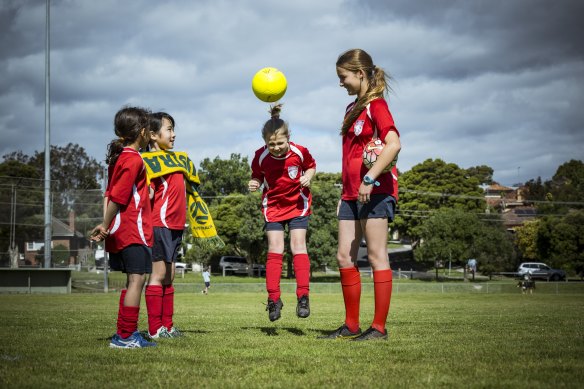
Members of the Darebin Falcons - l-r Willow, Colette, Greta and Artie - are getting ready to cheer on the Socceroos in their knockout game against Argentina at the 2022 World Cup. Credit: Chris Hopkins
Hurst says the Darebin Falcons work hard to keep costs down with unpaid volunteer coaches and fundraising through the canteen.
“It is a really big focus for us because we want to make the barriers to girls joining soccer clubs as low as possible,” she says. “Our uniform is the bare minimum so we don’t add on other things like bags and jumpers, it’s just the clothes you play in.”
Hurst says once players reach a certain level they generally leave clubs like the Darebin Falcons to join an NPL club.
“It’s a higher standard of competition, the coaches are paid with appropriate qualifications and the facilities are a lot better,” she says. “Our pitch is extremely muddy and dreadful in the winter and is just not conducive to good soccer.”
Fifteen-year-old Giulia Codini played for the Darebin Falcons for nine years before joining Heidelberg National Premier League club two years ago.
Codini says there was a big cost difference between the Darebin Falcons and Heidelberg but her family was able to commit the money.
“It is a higher intensity, it is NPL, so it is more of a commitment they have really good coaches and really good facilities and really good people around,” she says.
At the Lidcombe Waratah Soccer Club in Sydney’s West, club registrar Dimitri Chiris says numbers are down from 250 players to 175 and he says one of the factors is the high cost of registration.
“The last few years for us at the grassroots level have been smashed by COVID, rain and the cost of registration,” he says. “Football Australia uses grassroots registration fees to subsidise its operations, whereas that is the opposite to NRL and AFL, where the money trickles down from the top to encourage local participation.”
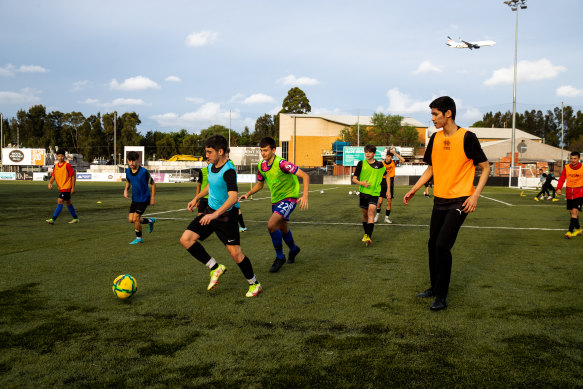
Children playing soccer at the Fraser Park Football Club in Marrickville. Credit: Edwina Pickles
Football Australia disputes this claim.
Fourteen-year-old Liam Batista plays for the Fraser Park Football Club in Marrickville and has had a passion for soccer ever since he saw Cristiano Ronaldo on television and thought “that’s what I want to do”.
Batista says he started out wanting to play National Rugby League but then switched to soccer and cost was not a factor in making his decision.
“I enjoy playing it with my mates and it’s good fun to be a Waratah,” he says.
Batista has been getting up early to watch all the Socceroos matches and says the World Cup has added to the excitement of playing the game.
“I love how it is only every four years so you are really excited to watch it,” he says. “To finally make it through to the round of 16, I am really proud.”
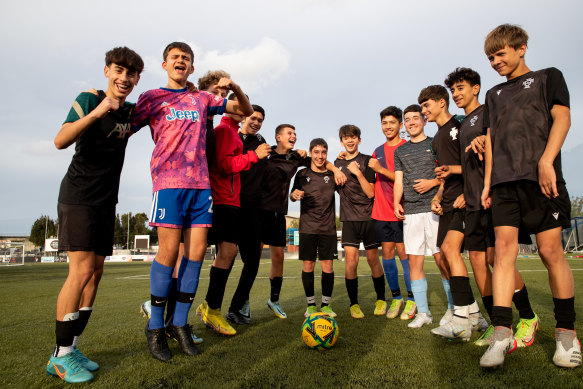
Kids at Fraser Park Football Club, Marrickville are staying up to watch the games. Credit: Edwina Pickles
Johnson said that while club registration fees for community soccer were “by and large pretty reasonable”, he accepted there were challenges at NPL level.
“These costs increased substantially from about 2013 and they are too high,” Johnson said. “And we’re conscious of that, and we will address it. Government subsidies do help, but it will require more, it will require a package of measures.”
The game received $2.7 million in the last federal budget to fund two junior multicultural programs. Federal Sports Minister Annika Wells was sitting with FIFA president Gianni Infantino when Craig Goodwin scored against France. She has pledged to revisit how government funds are distributed.
Jamieson is critical of how little government money the sport receives despite having the highest participation rate in the nation.
“It’s about football trying to really make a stand here and say ‘we deserve a piece of this pie’,” Jamieson said.
Even if the Socceroos’ World Cup ride crashes to a halt on Sunday, Arnold’s men have at the very least made a statement.
“I’m just excited that we’re here, and I think what that does is it sends a message both domestically and globally that we are a football nation and on both the men’s and the women’s side,” Johnson said. “And we will be more credible and we’ll be taking more seriously as a consequence.”
News, results and expert analysis from the weekend of sport sent every Monday. Sign up for our Sport newsletter.